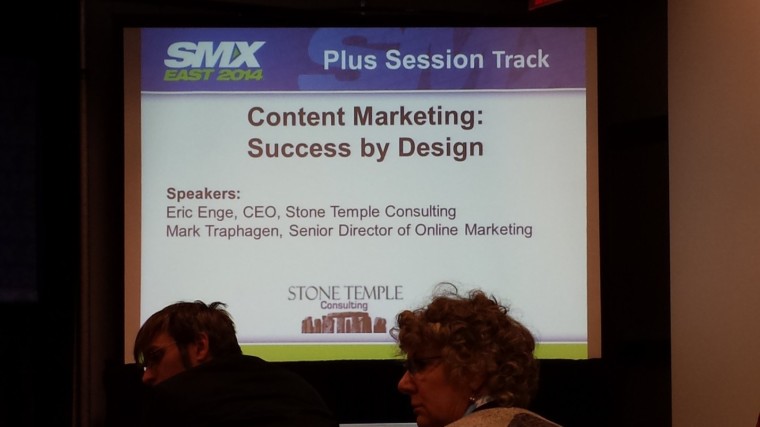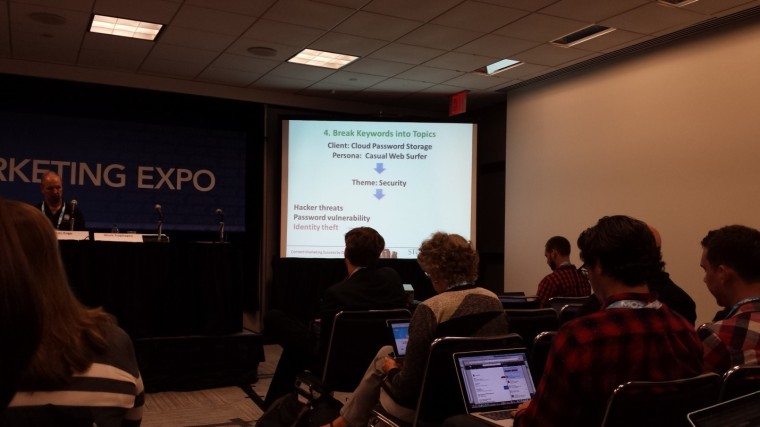I attended SMX East this year, and had the awesome opportunity to take in a wide variety of sessions. One of my favorites included “Content Marketing: Success by Design” with Eric Enge and Mark Traphagen. They gave a great presentation and offered plenty of great points designed to help brands take their content marketing efforts to the next level.
Below are a few insights I took away from the presentation.

Define Your Market Space
One of the main goals of content marketing is to get in front of other people’s audiences through guest posting. The first question you should ask yourself is, “Who are the other sites that are publishing content in our niche?” Once you’ve compiled a list of a number of publishing sites, the next step is to rank the sites based on their reputation, perception, and legitimacy within the industry. You should find the sites that are potential targets for your content and arrange them into a hierarchy.
Your hierarchy can stretch from “Golden Goose” all the way down to “Generally Bad”.
If you’re just starting out, the highest sites realistically aren’t going to publish your content just yet. In this situation, a good strategy is to find some of the “respectable” sites on your guest posting hierarchy that you can post on and then work your way up the ladder. Once you get a certain amount of content out in a certain sphere, you can leverage that to boost yourself to the next level. Climb the ladder one step at a time.

The Content Marketing Campaign Grid – Steps to Success
1. Identify Target Market Personas
- Start with Executives and then move down from there. Who is the end-user of the content that you are targeting? Build a model of who these people are – their education, hobbies, likes, and dislikes. This will help exponentially when it comes time to actually create the content.
2. Establish the Main Themes
- For the sake of explanation, here’s an example:
Client: Cloud Password Storage Company
Persona: Casual Web Surfer
Themes would include the pain points or needs of the persona. In this example it would include security, convenience and intelligence (easy to use). Something that can be put on autopilot without too much maintenance.
3. Collect Message Keywords
- Theme: Security
- Keywords: Hacker Threats, Password Vulnerability, Identity Theft
- It might take longer (more research) to do these steps, but will save you time in the long run. Brings to mind the old adage, “Do it right, or do it over.” Don’t skip out on important steps.
4. Break Down Themes into Topics
- Keyword: Identity Theft
- Based upon your persona and your message key words, brainstorm a few topics that would appeal to your market. A good example here is : “The True Cost of Identity Theft”

5. Find Outreach Targets (Publishers)
- At this point, you should go out to find the sites who are most likely to post your content. Again, start with respectable sites and step up from there. The end goal is always to get a post on high-end sites.
6. Identify Influencers
- You should leverage relationships you have built with industry influencers. If you don’t have any relationships, then make some! Find people you can network with, talk to on Social Media, and ask to help you share your content. Make sure it’s relevant to their audience and you’ll get a better response.
7. Identify SME’s (Subject Matter Experts)
- Who will produce the content? It makes much more sense to find someone to write the content once you’ve identified the purpose of the content, the target audience, and selected relevant topics.
- Ideally, you want to use qualified content writers who are already known in the industry and can add credibility to your cause. This may not always be possible, so consider doing research to find other people who might not be as well-known, but are still qualified to produce it.
- Bonus Tip: Brands must get over the fear of attributing real people to the content they create. As humans are programmed to respond to other people, not brands. A lot of fear comes from the worry that they will leave your company after they make a name for themselves. While this situation isn’t ideal, it isn’t all bad. Someone who moves on (under good terms) will still have their content listed on your site. If people see it then they’ll associate your work with the good writer and you’ll still gain some reputation and legitimacy from it.
Measure Twice, Cut Once
Ultimately, it’s important to plan out your guest posting/content marketing strategy beforehand to ensure you’re successful. Take the time to get it right the first time. It may take a bit longer to get things started, but you’re setting yourself (and your clients) up for success.
Look for the slides of this presentation to be available on Mark’s SlideShare profile shortly.
Image Credit: All photos taken by author for Search Engine Journal





